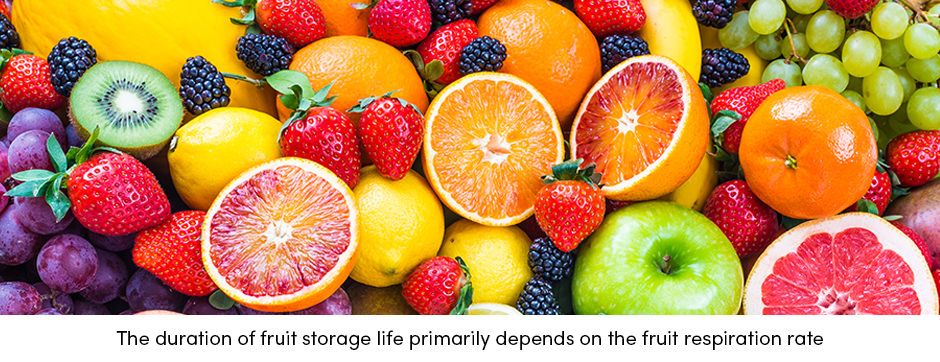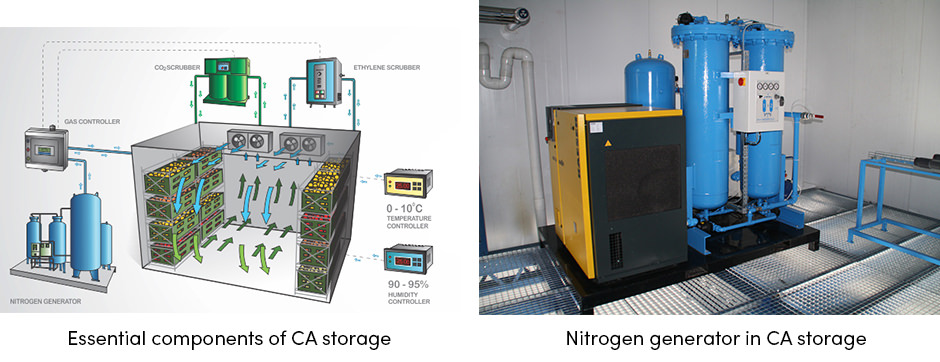ATMOSPHERE CONTROL
Erkar Industrial Cooling System

Once harvested and stored, vegetables and fruits still respire. By doing so they use oxygen and release carbon dioxide and heat. Fruit respiration is a multi-stage process that directly affects fruit storage life. For this reason, it’s in the farmer’s best interest to minimize the fruit respiration rate as much as possible and slow down the process of ripening. Thanks to modern technology, farmers can now manage the fruit respiration rate and prolong fruit storage life by using Controlled atmosphere storage (also called CA storage).
Controlled Atmosphere System as a Wonder of Storage Technology
CA technology has changed the face of post-harvest management. By enabling a farmer to take complete control over fruit respiration process, this remarkable technology exceeds boundaries of standard storage facilities such as cooling storage which only maintains relatively low temperatures.
More concretely, controlled atmosphere storage technology enables storing fruits and vegetables under precisely regulated and constantly monitored temperatures, humidity, and atmospheric conditions. Optimal atmospheric conditions are managed by regulating the level of oxygen, carbon dioxide, and nitrogen. Therefore, the atmosphere in CA storage differs significantly from the normal air in relation to carbon dioxide and oxygen levels. In this manner, CA storage actually postpones fruit ripening and provides long-term storage for fruits and vegetables.
CA Technology- Types and Processes in Brief
Controlled atmosphere technology is a fresh perspective in fruit and vegetable storage management that provides three imperative functions:
1. Temperature control; temperature is managed through standard refrigeration system which includes refrigeration pipes containing a refrigerant inside the storage.
2. Humidity control; since most fruits and vegetables stored in CA require a high relative humidity, various humidifying devices can be used to manage the moisture in the air.
3. Atmospheric conditioning; optimal levels of oxygen and carbon dioxide are managed differently in each CA storage type.

There are few different types of CA storage facilities, depending on the method of controlled atmospheric conditions, as well as the type of the construction (stationary CA storage buildings or movable CA containers).
Regardless of the type of CA storage, a gas-tight room is a prerequisite for achieving controlled atmospheric conditions. Therefore, a care should be taken on proper insulation and adequate gas- tight doors. Sealed CA chambers go through many pressure changes during the storage season. Therefore, they are often equipped with pressure release valves or expansion bags that are gas-tight and usually placed near the doors from both sides of storage.
Besides aforementioned components (refrigeration system, humidifying devices, and gas-tight chamber) CA storage system includes:
Nitrogen generator; selectively separates air to produce an enriched nitrogen system, thus reducing oxygen level
Carbon dioxide and ethylene scrubber; devices that absorb excessive carbon dioxide or ethylene
Carbon dioxide, oxygen, and ethylene sensor that measure oxygen and carbon dioxide concentration in the storage
Temperature/humidity sensors
Gas display controller that manages ventilation, nitrogen inlet or control of scrubbers.
What About the Atmosphere
Atmospheric conditions in CA storage can be managed in several ways. However, many CA systems are static (also known as a product generated). This means that the oxygen level is first reduced by the respiration of the fruits. When the oxygen reaches its required level, it’s maintained by ventilation that introduces fresh air from outside of the storage. When the carbon dioxide or ethylene level increases due to fruit respiration, it’s removed either by ventilation or by using carbon dioxide and ethylene scrubbers. This method is called active scrubbing.
Besides active scrubbing, carbon dioxide may be removed by introducing the chemical for its removal and keeping it at generally low levels. This method is also known as passive scrubbing.
Another method of managing atmospheric conditions in CA storage is called dynamic controlled atmosphere system that uses sensors and responds to the change of physiological conditions of the fruits and then automatically adjusts the storage conditions.
